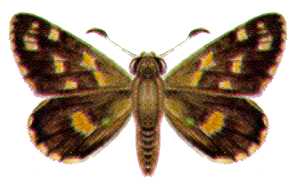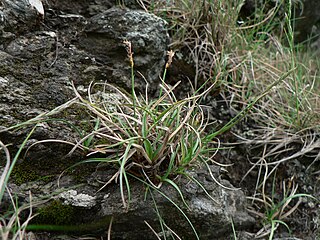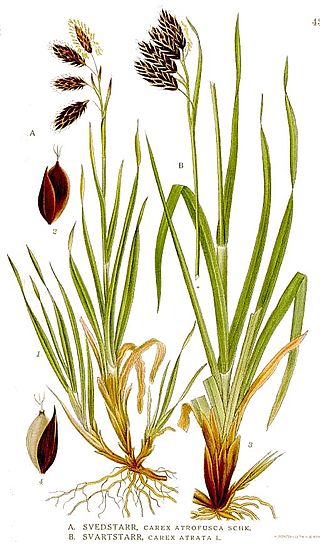
Dianella tasmanica, commonly known as the Tasman flax-lily or Tasmanian flax-lily is a herbaceous strappy perennial herb of the family Asphodelaceae, subfamily Hemerocallidoideae, found in southeastern Australia including Tasmania. It has leaves to 80 cm, and a flower stem to 1.5 m. Blue flowers in spring and summer are followed by violet berries. It adapts readily to cultivation and is commonly seen in Australian gardens. Unlike other Dianella species, its fruit is toxic.

Uncinia is a genus of flowering plants in the family Cyperaceae, known as hook-sedges in Australia and as hook grasses or bastard grasses in New Zealand. The genus is characterised by the presence of a long hook formed by an extension of the rachilla, which is used to attach the fruit to passing animals (epizoochory), especially birds, and it is this feature which gives the genus its name, from the Latin uncinus, meaning a hook or barb.

Hesperilla munionga, the alpine sedge-skipper, is a butterfly of the family Hesperiidae. It is found in the Australian Capital Territory, New South Wales, Tasmania and Victoria.

Carex sect. Spirostachyae is a section of the genus Carex, containing 38 species of sedge. Species in Carex sect. Spirostachyae share a suite of features, including the short internodes of the primary rhizomes, the presence of an antiligule, the leaf-like, sheathing bract at the base of the inflorescence, the presence of three stigmas in female flowers, and the shape of the seeds.

Carex archeri, known as Archer's sedge, is a species of sedge in the genus Carex, endemic to south-eastern Australia.

Carex banksii is a species of flowering plant in the sedge family, Cyperaceae. Carex banksii is native to South America and was first formally named by Francis Boott in 1839.

Carex capillacea, common name yellowleaf sedge in Tasmania, is a species of sedge found in Assam, the far east of Russia, New Guinea, south east Australia, New Zealand, Malesia, China, Japan and India.
Carex gunniana is an Australia species of sedge that was first described in 1845 by Boott in the Proceedings of the Linnean Society of London. It is native to eastern Australia and Tasmania.

Carex lanceolata is a species of sedge, native to the eastern half of China, Mongolia, eastern Siberia, Korea, Sakhalin, and Japan. Its seeds are dispersed by ants.
Carex tereticaulis, also known as basket sedge, is a species of sedge of the family Cyperaceae that is native to southern parts of Western Australia, southern parts of South Australia, southern and eastern parts of New South Wales as well as north western and central Victoria and Tasmania. The Koori peoples know the plant as Poong'ort.

Carex rupestris, called the curly sedge and rock sedge, is a species of flowering plant in the family Cyperaceae, native to temperate and subarctic North America, Greenland, Iceland, Europe, and Asia. It prefers to grow on rocky ledges.

Carex atrata, called black alpine sedge, is a widespread species of flowering plant in the genus Carex, native to Greenland, Iceland, and most of Europe, plus scattered locations across temperate Asia, including Anatolia, Siberia and the Himalaya, as far as Taiwan and Japan. Its chromosome number is 2n=52, with some variants reported, e.g. n2=54 for Greenland material.

Carex divulsa, the grey sedge, is a species of flowering plant in the genus Carex, native to Macaronesia, Europe, northwest Africa, the Caucasus region, and the Middle East as far east as Turkmenistan. It has been introduced to northeast Argentina, the District of Columbia and Pennsylvania in the United States, Ontario in Canada, the North Island of New Zealand, and Tasmania and Victoria in Australia. It is the namesake of the Carex divulsa aggregate.

Carex breviculmis, called the Asian shortstem sedge, is a species of flowering plant in the genus Carex, native to Asia from the Indian subcontinent to Southeast Asia, China, Taiwan, Korea, Japan, north as far as Khabarovsk Krai, and Malesia, New Guinea, Australia, Norfolk Island and New Zealand. It has been introduced to the US state of Mississippi. Typically found in forests, it is quite shade tolerant.

Carex tristachya, called the shiny-spike sedge, is a species of flowering plant in the genus Carex, native to south-central and southeast China, Korea, Japan, the Ryukyus, the Philippines, Borneo, and New Guinea. Its seeds are dispersed by ants.

Carex gaudichaudiana, also known as fen sedge, is a tussock-forming species of perennial sedge in the family Cyperaceae. It is native to parts of Australia and New Zealand.
Carex iynx, the tussock sedge, is a species of flowering plant in the family Cyperaceae, native to South Australia, New South Wales, Victoria, and Tasmania in Australia, and introduced to the North Island of New Zealand. It superficially resembles Carex tasmanica, the curly sedge.
Carex cephalotes, also known as wire-head sedge, is a tussock-forming species of perennial sedge in the family Cyperaceae. It is native to south eastern Australia and New Zealand.
Carex polyantha, commonly known as river sedge, is a tussock-forming species of perennial sedge in the family Cyperaceae. It is native to eastern parts of Australia.













